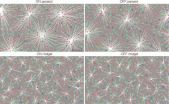(Press-News.org) LA JOLLA, CA-By comparing a clearly defined visual input with the electrical output of the retina, researchers at the Salk Institute for Biological Studies were able to trace for the first time the neuronal circuitry that connects individual photoreceptors with retinal ganglion cells, the neurons that carry visuals signals from the eye to the brain.
Their measurements, published in the Oct. 7, 2010, issue of the journal Nature, not only reveal computations in a neural circuit at the elementary resolution of individual neurons but also shed light on the neural code used by the retina to relay color information to the brain.
"Nobody has ever seen the entire input-output transformation performed by complete circuits in the retina at single-cell resolution," says senior author E.J. Chichilnisky, Ph.D., an associate professor in the Systems Neurobiology Laboratories. "We think these data will allow us to more deeply understand neuronal
computations in the visual system and ultimately may help us construct better retinal implants."
One of the essential elements that made the experiments possible was the unique neural recording system developed by an international team of high-energy physicists from the University of California, Santa Cruz; the AGH University of Science and Technology, Krakow, Poland; and the University of Glasgow, UK. This system is able to record simultaneously the tiny electrical signals generated by hundreds of the retinal output neurons that transmit information about the outside visual world to the brain. These recordings are made at high-speed (over ten million samples each second) and with fine spatial detail, sufficient to detect even a locally complete population of the tiny and densely spaced output cells known as "midget" retinal ganglion cells.
Retinal ganglion cells are classified based on their size, the connections they form, and their responses to visual stimulation, which can vary widely. Despite their differences, they all have one thing in common-a long axon that extends into the brain and forms part of the optic nerve.
Visual processing begins when photons entering the eye strike one or more of the 125 million light-sensitive nerve cells in the retina. This first layer of cells, which are known as rods and cones, converts the information into electrical signals and sends them to an intermediate layer, which in turn relays signals to the 20 or so distinct types of retinal ganglion cells.
In an earlier study, Chichilnisky and his team found that each type of retinal ganglion cells forms a seamless lattice covering visual space that transmits a complete visual image to the brain. In the current study, postdoctoral researcher and co-first author Greg D. Field, Ph.D., and his collaborators zoomed in on the pattern of connectivity between these layers of retinal ganglion cells and the full lattice of cone receptors.
The Salk researchers simultaneously recorded hundreds of retinal ganglion cells, and based on density and light response properties, identified five cell types: ON and OFF midget cells, ON and OFF parasol cells, and small bistratified cells, which collectively account for approximately 75 percent of all retinal ganglion cells.
To resolve the fine structure of receptive fields-the small, irregularly shaped windows through which neurons in retina view the world-the authors used stimuli with tenfold smaller pixels. "Instead of a diffuse region of light sensitivity, we detected punctate islands of light sensitivity separated by regions of no light sensitivity," he says.
When combined with information on spectral sensitivities of individual cones, maps of these punctate islands not only allowed the researchers to recreate the full cone mosaic found in the retina, but also to conclude which cone fed information to which retinal ganglion cell.
"Just by stimulating input cells and taking a high density recording from output cells, we can identify all individual input and output cells and find out who is connected to whom," says Chichilnisky.
Chichilnisky and his team discovered that populations of ON and OFF midget and parasol cells each sampled the complete population of cones sensitive to red or green light, with midget cells sampling these cones in a surprisingly non-random fashion. Only OFF midget cells frequently received strong input from cones sensitive to blue light.
INFORMATION:
The research was funded in part by the Helen Hay Whitney Foundation, the German Research Foundation, the National Institutes of Health, the Chapman Foundation, the Miller Institute for Basic Research in Science, the Polish Ministry of Science and Higher Education, the Burroughs Wellcome Trust, the McKnight Foundation, the National Science Foundation, the Sloan Foundation, the Engineering and Physical Sciences Research Council and The Royal Society of Edinburgh.
Researchers who also contributed to the work include co-first author Jeffrey L. Gauthier, Ph.D., Martin Greschner, Timothy A. Machado, Lauren H. Jepson, and Jonathon Shlens in the Systems Neurobiology Laboratory at the Salk Institute, co-first author Alexander Sher and Alan Litke at the Santa Cruz Institute for Particle Physics at the University of California, Santa Cruz, Deborah E. Gunning and Keith Mathieson in the Department of Physics and Astronomy at the University of Glasgow, Wladyslaw Dabrowski at the Faculty of Physics and Applied Computer Science at the AGH University of Science and Technology in Krakow, and Liam Paninski in the Department of Statistics and Center for Theoretical Neuroscience at Columbia University, New York.
About the Salk Institute for Biological Studies:
The Salk Institute for Biological Studies is one of the world's preeminent basic research institutions, where internationally renowned faculty probe fundamental life science questions in a unique, collaborative, and creative environment. Focused both on discovery and on mentoring future generations of researchers, Salk scientists make groundbreaking contributions to our understanding of cancer, aging, Alzheimer's, diabetes and infectious diseases by studying neuroscience, genetics, cell and plant biology, and related disciplines.
Faculty achievements have been recognized with numerous honors, including Nobel Prizes and memberships in the National Academy of Sciences. Founded in 1960 by polio vaccine pioneer Jonas Salk, M.D., the Institute is an independent nonprofit organization and architectural landmark.
The Salk Institute proudly celebrates five decades of scientific excellence in basic research.
From eye to brain
Salk researchers map functional connections between retinal neurons at single-cell resolution
2010-10-07
ELSE PRESS RELEASES FROM THIS DATE:
Blood pressure breakthrough holds real hope for treatment of pre-eclampsia
2010-10-07
Scientists have discovered a mechanism which raises blood pressure in pre-eclampsia, a potentially deadly condition which occurs during pregnancy.
After 20 years of research, scientists from the University of Cambridge have now cracked the first step in the main process that controls blood pressure. Their findings, published today in the journal Nature, are likely to have significant implications for the treatment of pre-eclampsia as well as high blood pressure (also known as hypertension).
Blood pressure is controlled by hormones called angiotensins, which cause ...
Research identifies the herbal supplements that are effective in treating anxiety
2010-10-07
A systematic review of research into the use of nutritional supplements for the treatment of anxiety disorders has found strong evidence for the use of extracts of passionflower or kava and combinations of L-lysine and L-arginine. Researchers writing in BioMed Central's open access Nutrition Journal pooled the results of 24 studies involving a total of more than 2000 participants, showing that some nutritional and herbal supplements can be effective, without the risk of serious side effects.
The research was carried out by Shaheen Lakhan and Karen Vieira from the Global ...
Stressed-out mums may worsen their child's asthma
2010-10-07
Mums who are often angry or irritated and those who suppress their emotional expressions can worsen the severity of their children's asthma symptoms, especially when the children are younger. Researchers writing in BioMed Central's open access journal BioPsychoSocial Medicine studied 223 mothers for a year , investigating how their stress levels, coping styles and parenting styles were associated with their 2 to 12 year old children's disease status.
Jun Nagano, from the Kyushu University Institute of Health Science, Fukuoka, Japan, worked with a team of researchers ...
Novel approach yields new insights into the causes of pre-eclampsia
2010-10-07
An exciting collaboration between the Universities of Cambridge and Nottingham has resulted in new insights into the hypertension that frequently blights pregnancy.
The results, published in the journal Nature [online 6th October], describe the solving of the first step in the principal process that controls blood pressure — the release of the hormone angiotensin from its source protein, angiotensinogen.
Every day, millions of people are treated with drugs which either block the production of angiotensin, (ACE inhibitors), or stop it from taking effect in the body once ...
Vitamin D deficiency rampant in patients undergoing orthopedic surgery, damaging patient recovery
2010-10-07
Almost 50 percent of patients undergoing orthopedic surgery have vitamin D deficiency that should be corrected before surgery to improve patient outcomes, based on a study by researchers at Hospital for Special Surgery (HSS) in New York City. Vitamin D is essential for bone healing and muscle function and is critical for a patient's recovery. The study appears in the October issue of The Journal of Bone and Joint Surgery.
"In the perfect world, test levels, fix and then operate," said Joseph Lane, M.D., professor of Orthopedic Surgery and chief of the Metabolic Bone Disease ...
Female Cantabrian bears and their young do not hibernate
2010-10-07
A team of Spanish scientists followed the brown bear population through the mountains of the Cantabrian Cordillera between 1998 and 2007 in order to find out about their hibernation habits, which had been questioned in historical documents. The results confirm that female bears with babies and independent young bears under the age of two do not usually hibernate, while the other bears follow normal hibernation patterns.
Brown bears (Ursus arctos) all over the world hibernate, but according to historical documents this is not always the case. The Libro de la Montería by ...
Reviving the FDA: NEJM perspective
2010-10-07
Washington, DC – In a Perspective piece published online today in the New England Journal of Medicine, Georgetown University School of Medicine family medicine physician Susan Okie gives a comprehensive overview of change, and planned change, within the Food and Drug Administration (FDA). The review comes as the FDA's commissioner, Margaret Hamburg, completes her first year as the agency's leader.
Okie writes that the FDA's priorities over the past year have included "finding ways to make the FDA more nimble and proactive, restoring its credibility and refocusing staff ...
Vultures use face flushing technique for instant status updates
2010-10-07
Tech savvy humans who use social media sites to instantly update their 'statuses', may be behaving like vultures who use 'face flushing' as a visible way of instantly updating their own status when interacting with peers and rivals. Research, published in Ethology, reveals how the ability to rapidly change skin colour is a key form of interaction for vultures, especially for displays of dominance.
The ability to rapidly change skin colour has been well documented in reptiles and fish, which use specialist cells to disperse and concentrate pigments. However, the ability ...
VISTA reveals the secret of the unicorn
2010-10-07
An active stellar nursery lies hidden inside a massive dark cloud rich in molecules and dust in the constellation of Monoceros. Although it appears close in the sky to the more familiar Orion Nebula it is actually almost twice as far from Earth, at a distance of about 2700 light-years. In visible light a grouping of massive hot stars creates a beautiful collection of reflection nebulae where the bluish starlight is scattered from parts of the dark, foggy outer layers of the molecular cloud. However, most of the new-born massive stars remain hidden as the thick interstellar ...
Nano drugs
2010-10-07
Researchers in India have demonstrated that producing nanoscopic crystals of a pharmaceutical product can allow the medication to be absorbed by the gut even if the drug is not soluble in water.
Research suggests that more than half of the medicinal drugs being developed by the pharmaceutical industry dissolve only very weakly in water, if at all. This is a major problem for administering such drugs as it means they are not effective if taken by mouth. The industry has developed many approaches to addressing this problem, such as adding a small quantity of an organic ...
LAST 30 PRESS RELEASES:
Numbers in our sights affect how we perceive space
SIMJ announces global collaborative book project in commemoration of its 75th anniversary
Air pollution exposure and birth weight
Obstructive sleep apnea risk and mental health conditions among older adults
How talking slows eye movements behind the wheel
The Ceramic Society of Japan’s Oxoate Ceramics Research Association launches new international book project
Heart-brain connection: international study reveals the role of the vagus nerve in keeping the heart young
Researchers identify Rb1 as a predictive biomarker for a new therapeutic strategy in some breast cancers
Survey reveals ethical gaps slowing AI adoption in pediatric surgery
Stimulant ADHD medications work differently than thought
AI overestimates how smart people are, according to HSE economists
HSE researchers create genome-wide map of quadruplexes
Scientists boost cell "powerhouses" to burn more calories
Automatic label checking: The missing step in making reliable medical AI
Low daily alcohol intake linked to 50% heightened mouth cancer risk in India
American Meteorological Society announces Rick Spinrad as 2026 President-Elect
Biomass-based carbon capture spotlighted in newly released global climate webinar recording
Illuminating invisible nano pollutants: advanced bioimaging tracks the full journey of emerging nanoscale contaminants in living systems
How does age affect recovery from spinal cord injury?
Novel AI tool offers prognosis for patients with head and neck cancer
Fathers’ microplastic exposure tied to their children’s metabolic problems
Research validates laboratory model for studying high-grade serous ovarian cancer
SIR 2026 delivers transformative breakthroughs in minimally invasive medicine to improve patient care
Stem Cell Reports most downloaded papers of 2025 highlight the breadth and impact of stem cell research
Oxford-led study estimates NHS spends around 3% of its primary and secondary care budget on the health impacts of heat and cold in England
A researcher’s long quest leads to a smart composite breakthrough
Urban wild bees act as “microbial sensors” of city health.
New study finds where you live affects recovery after a hip fracture
Forecasting the impact of fully automated vehicle adoption on US road traffic injuries
Alcohol-related hospitalizations from 2016 to 2022
[Press-News.org] From eye to brainSalk researchers map functional connections between retinal neurons at single-cell resolution


